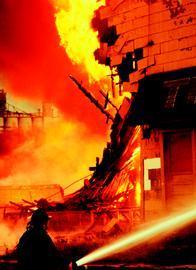It was with this philosophy in mind that Galea developed the Exodus evacuation software, which brings together a range of different modelling components, with behaviour the most important of these. "The model tries to capture the important behavioural rules of how people will respond in various situations. But those rules are based on the nature of the occupant and their abilities, and also based on the structure they are in and the environment around them. We don't introduce every aspect of human behaviour, we're still doing a lot of research, but at least we're beginning to address all of these issues."
The tools have been used to look at past events, most notably the evacuation of World Trade Centre One. Galea's team took 400 people's accounts of their behaviour, analysed them, entered the information into their evacuation model and simulated it. "We know there were around 7000 people in the building at the time of impact. We took out the number of people we know perished on the impact level and the floors above and ran the model. The model tells us that it takes about one hour and thirty-one minutes to get those people out, and the building collapsed in one hour and forty-two, so it shows us that we are in the right ball park and we could get every one out who was able to get out before the building collapses. Looking at response times in this model though, some people took as long as sixty minutes before they started to evacuate, even in the first tower that was hit."
This level of behavioural information is what allows the Exodus tool to be so accurate in simulating the time it takes for people to get out of a building. Allied to Exodus, Galea's Smartfire tool can be used to see how the fire affects the people trying to get out. "You need to be able to calculate and predict toxic gas generation and spread," he says. "The level of carbon monoxide is what kills people so it's crucial to model that to see how it will spread."
The software enables the modeller to simulate conditions with different types of cable in the environment to look at the gases they give off and how those gases spread through the structure. When this programme is used in conjunction with Exodus, the whole impact of the fire on the occupants can be demonstrated, and the model becomes an even more powerful simulation tool, to the extent that the people in the building can be seen having to crawl through the smoke as it descends to the floor.
To demonstrate the power of the combined approach, Galea uses an example of a tragedy that occurred in a Swedish first floor disco, where furniture stored in one of the building's fire exits was deliberately torched, leading to 63 deaths and 180 injuries. "Our colleagues in Sweden had done an evacuation calculation and a separate fire calculation so we brought the two together and simulated the actual event: people reacting to a fire and trying to evacuate this upper storey building through one available exit."
Viewing the simulation makes for a chilling experience, as figures crowd towards the exit, some with the letter H hovering over their heads, denoting them as close to death from the heat, and other with Ts, indicating near death from the toxic fumes given off by the smoke. White marks on the floor represent the chalk marks made by investigators of where the bodies fell. "When we simulated that disaster, our prediction said that 94 would die and 158 would be injured, so we were not that far off the reality. As an engineer looking at design criteria, you would come to the same conclusion," says Galea.
When the tragedy occurred, the venue was exceeding its capacity by three times the legal number, and when modelled with the permitted number the simulation showed that everyone managed to get out of the burning building.
While this software has shown what it can do to investigate past events, examples like this also display the advantages that this combined approach can bring in terms of what to expect from a design, as Galea says: "This software allows conditions to be modelled rather than assumed. It doesn't replace the engineer's need to think, but it should encourage a questioning approach. We should use these tools to probe and ask questions of the building. This partnership of sound engineering and judgement should help to make our environment better by design."
Source
Building Sustainable Design





















No comments yet